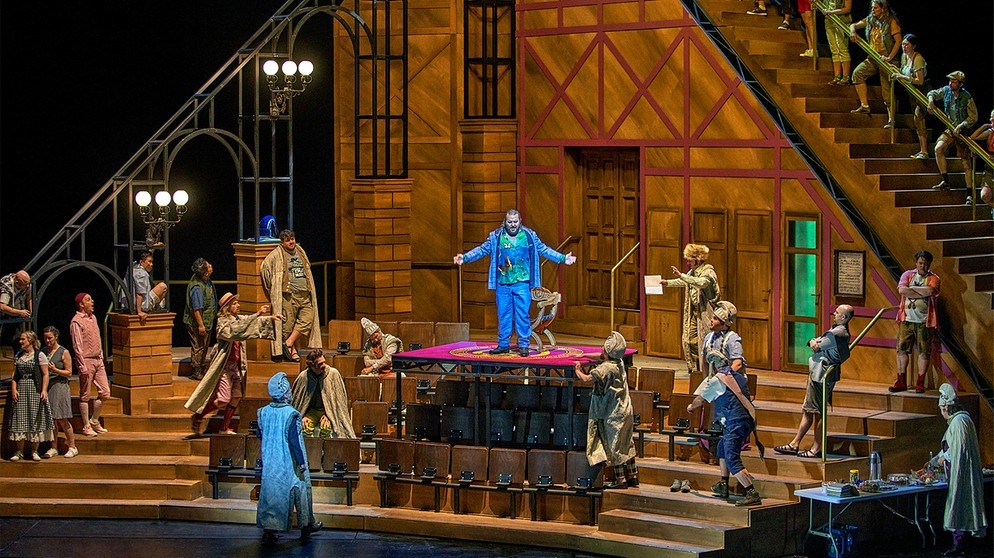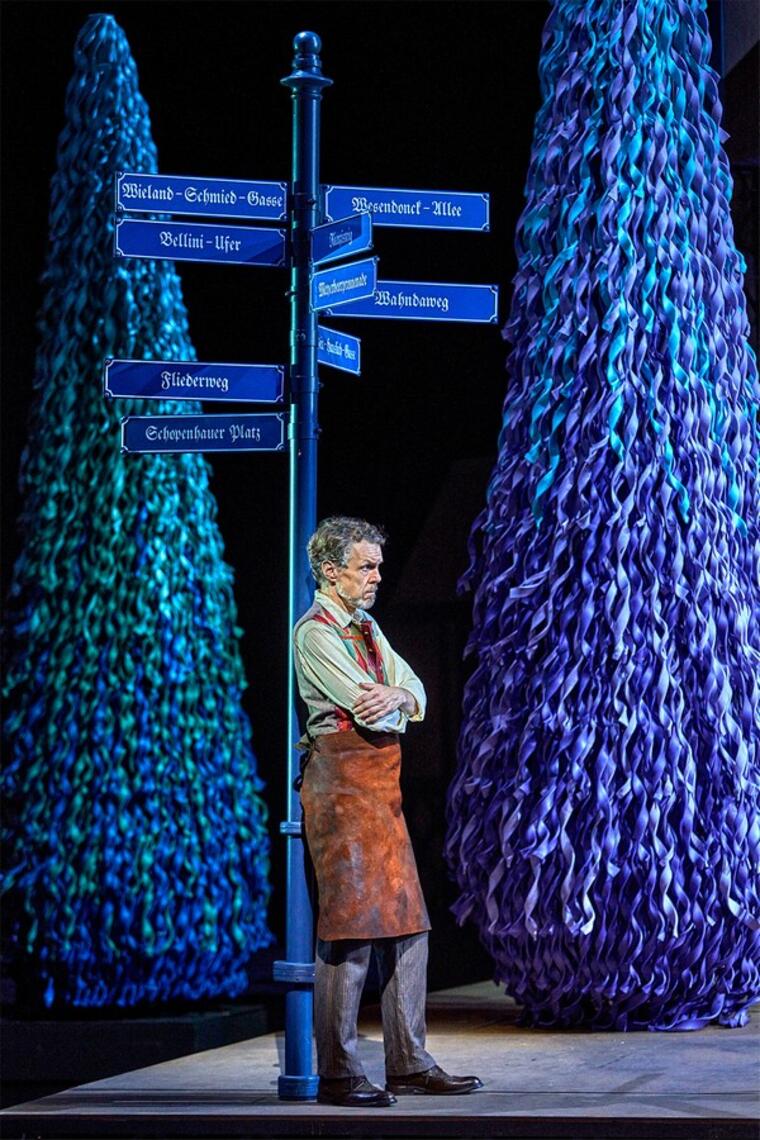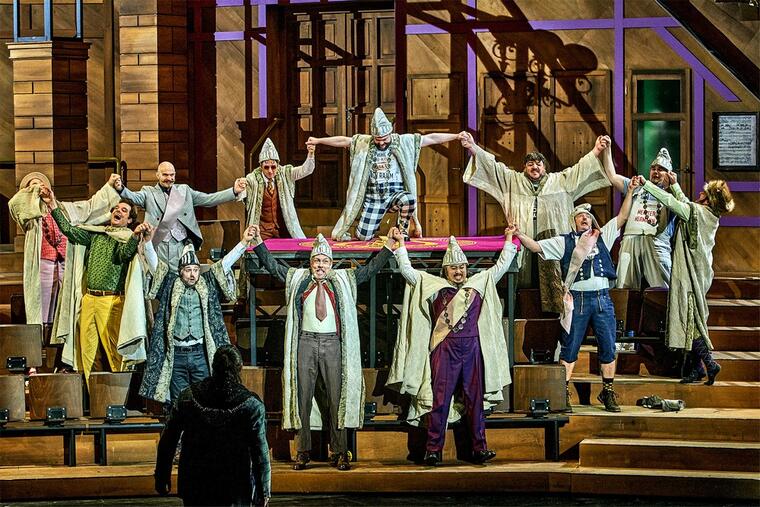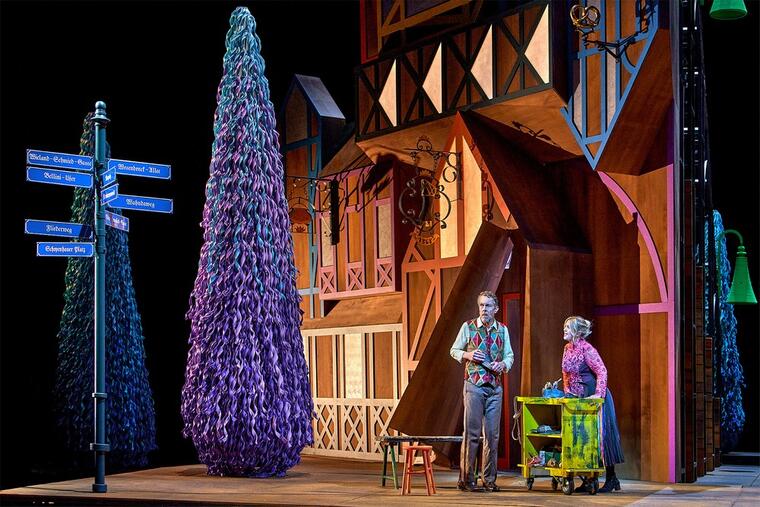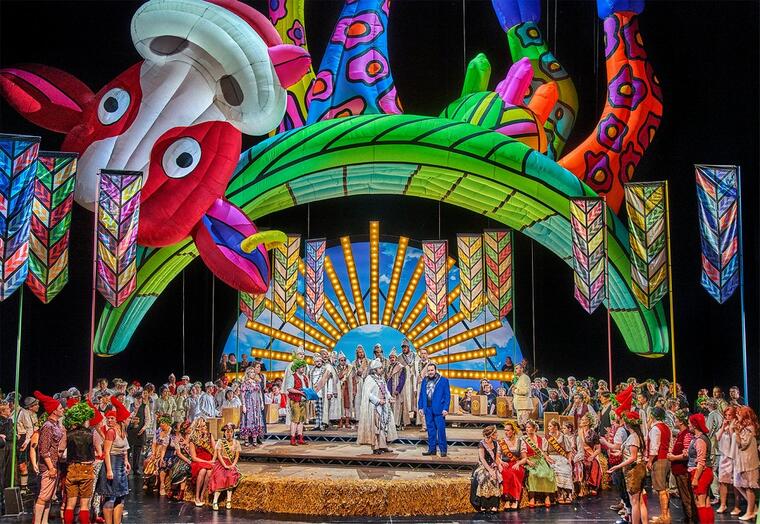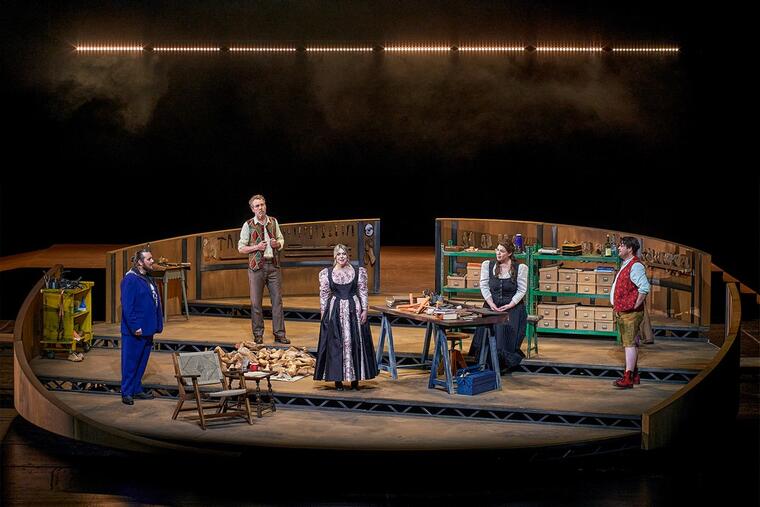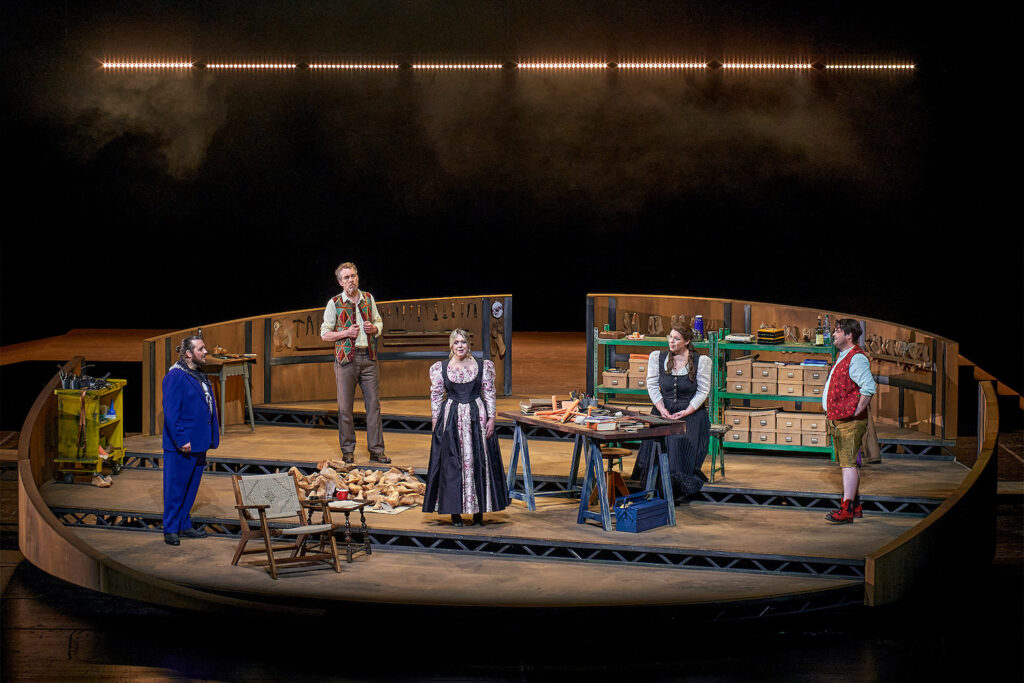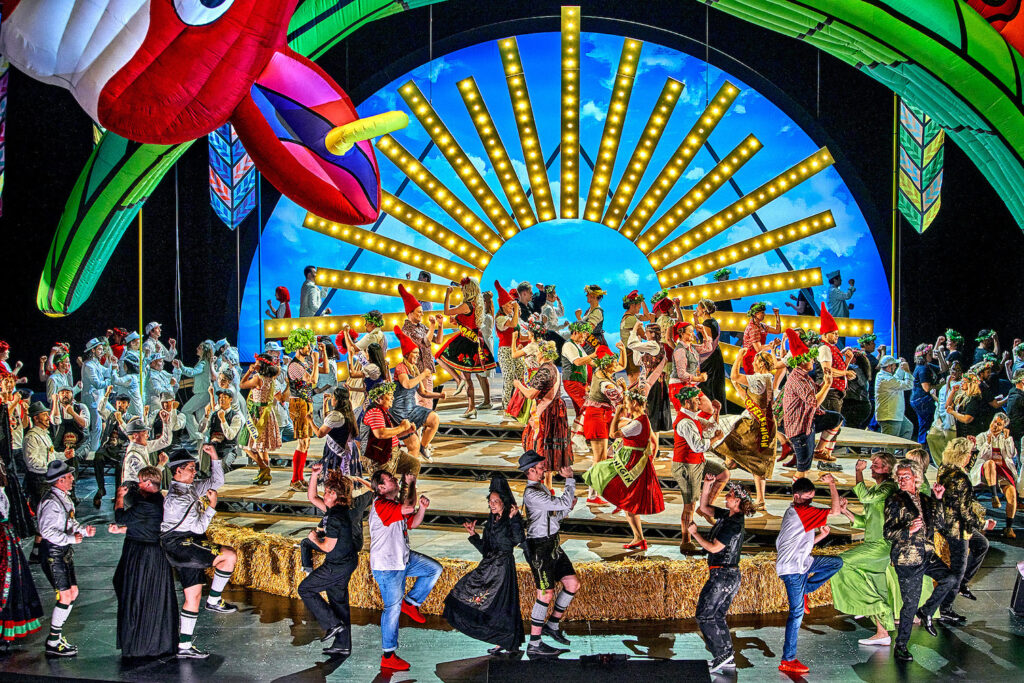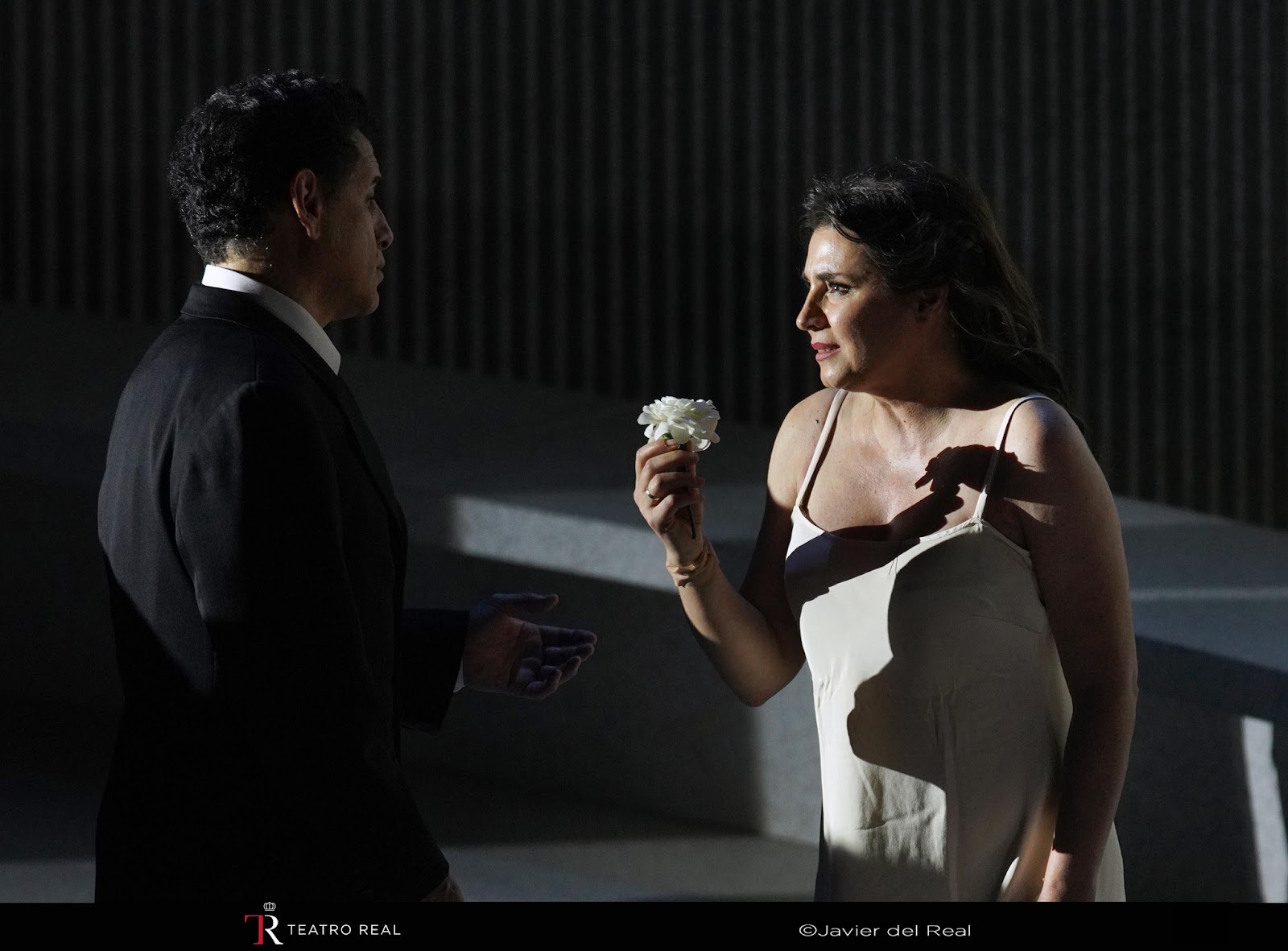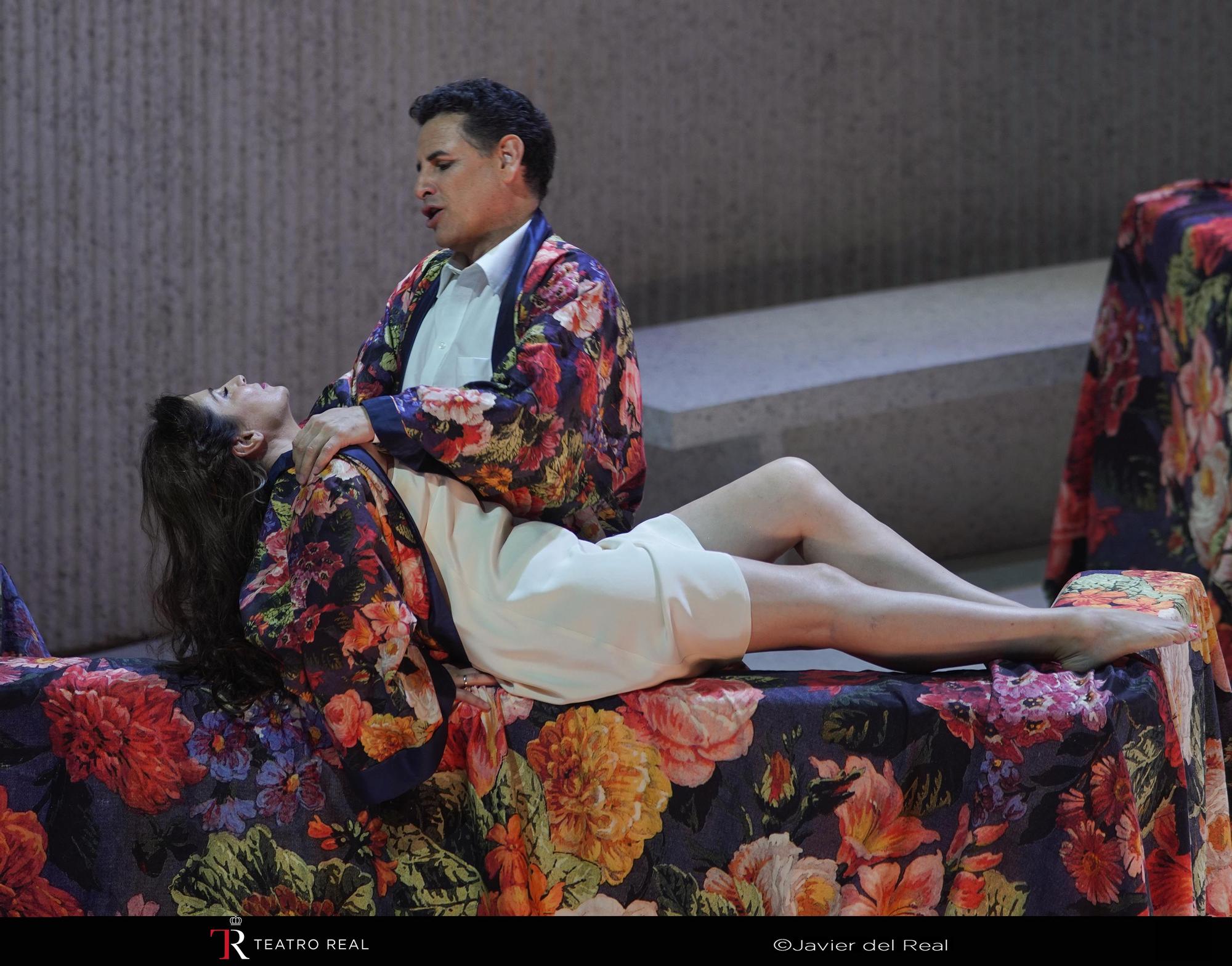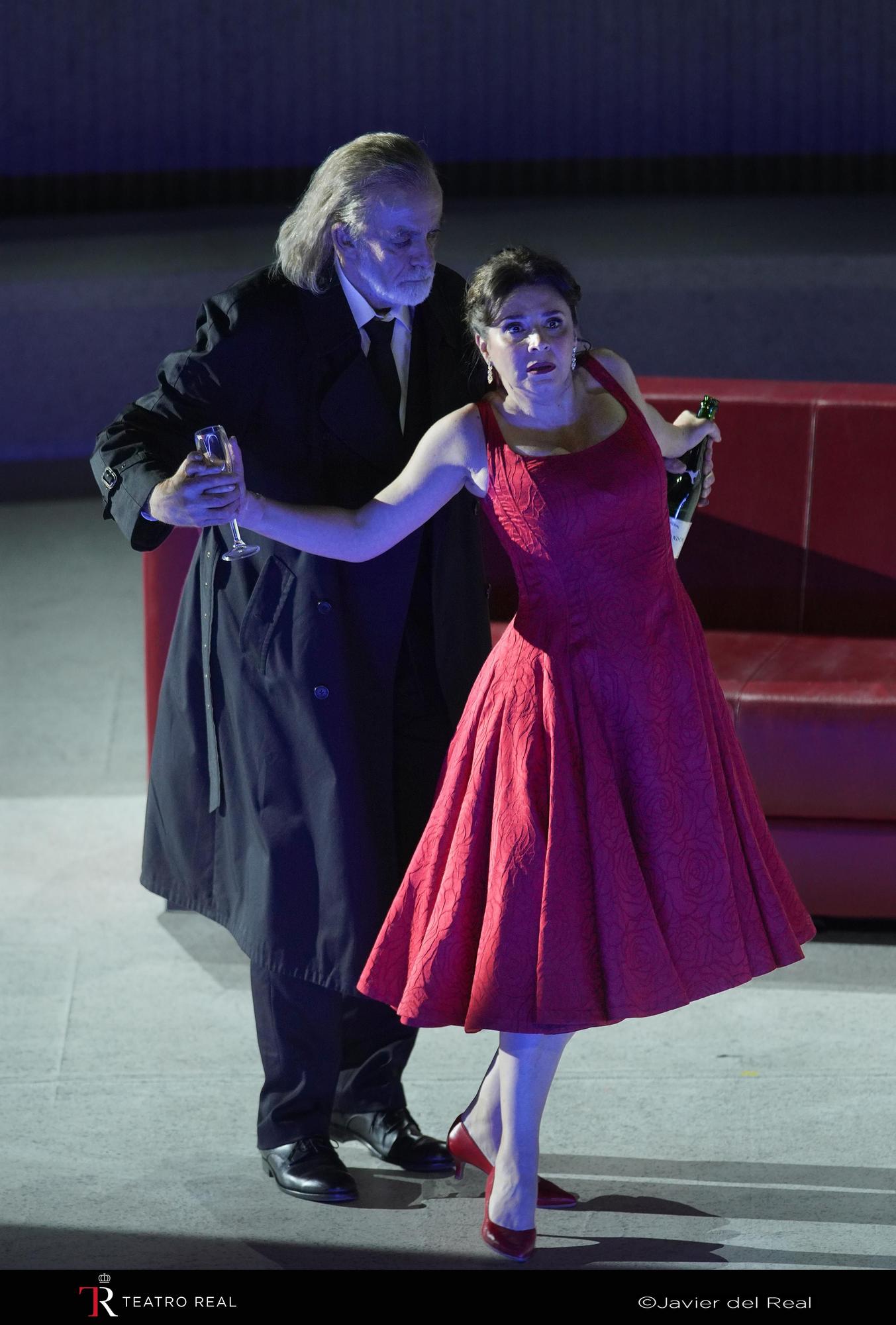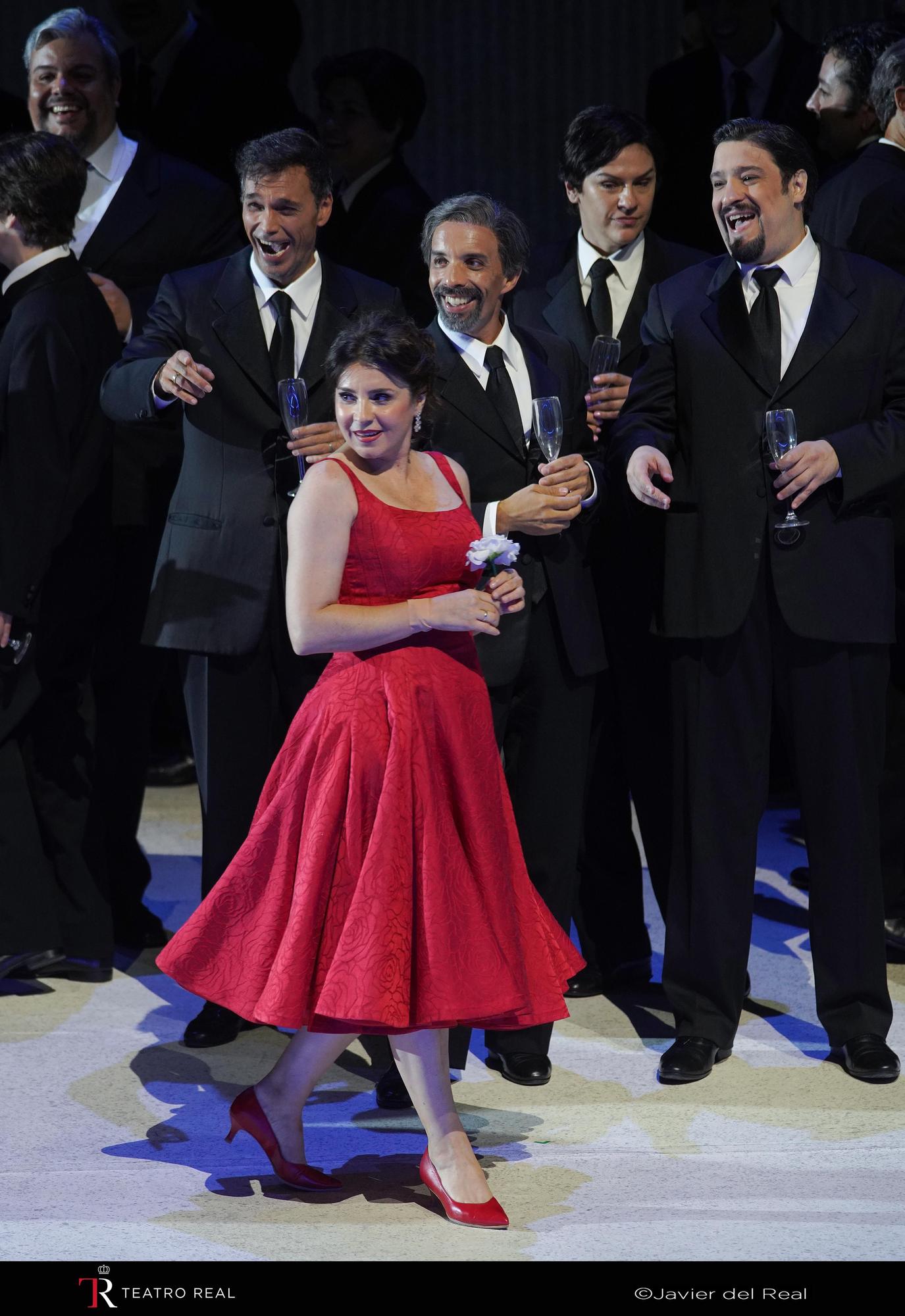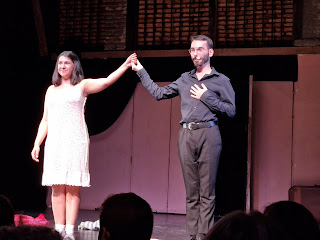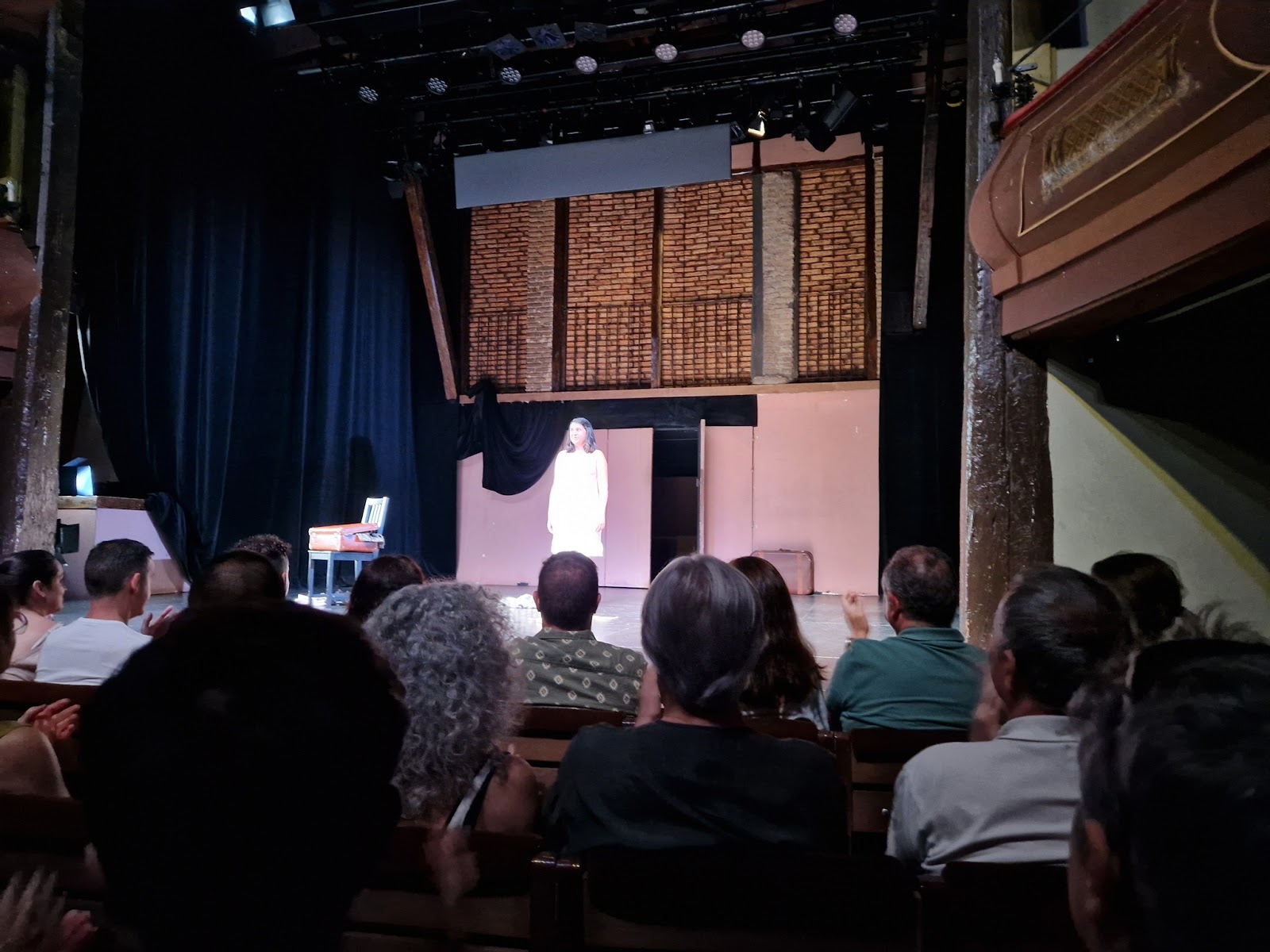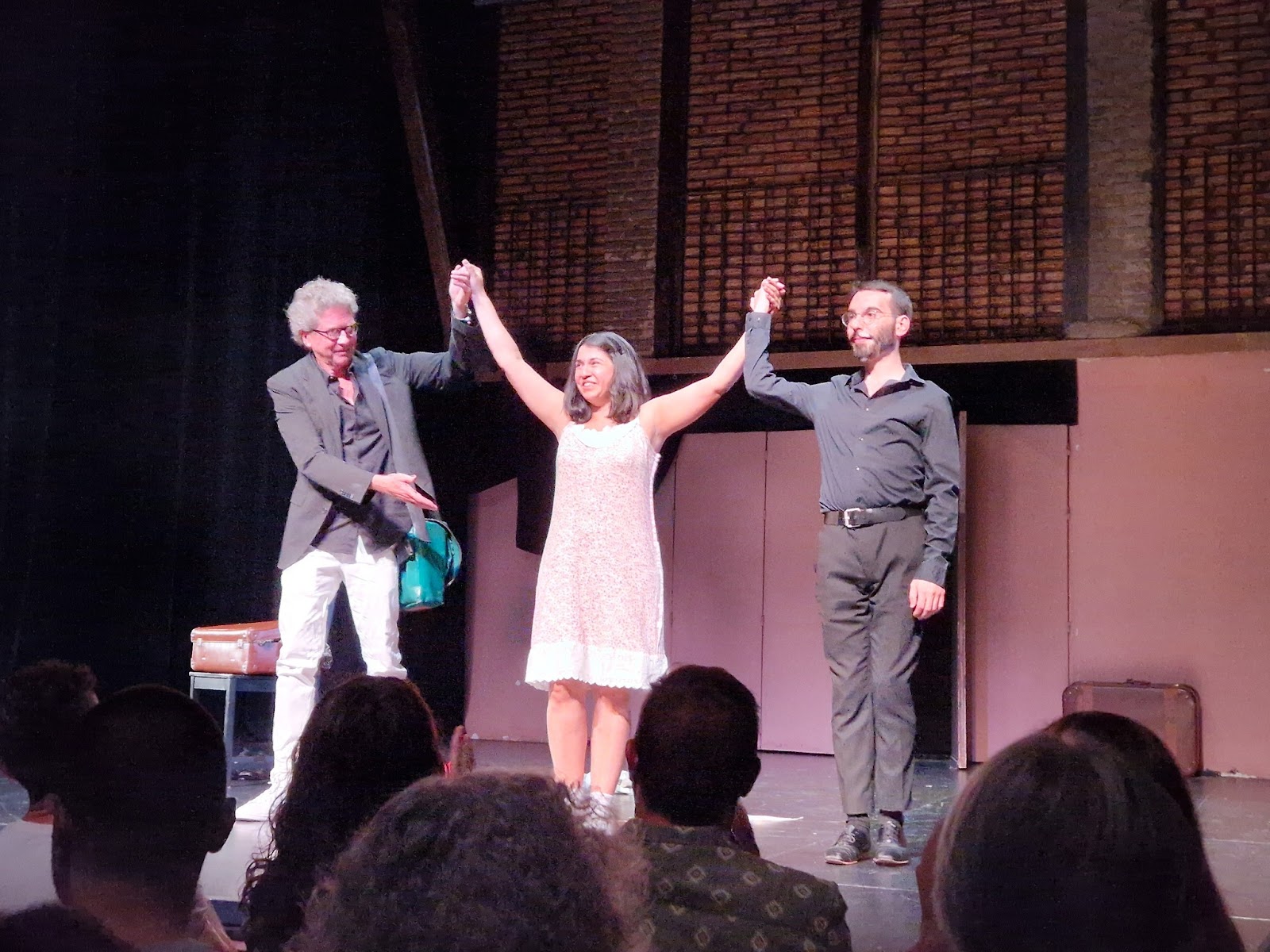Emociones Líricas
martes, 29 de julio de 2025
Die Meistersinger, the musical: new staging of Wagner's comedy in Bayreuth.
Los Maestros Cantores, el musical: vuelve a Bayreuth la comedia wagneriana.
Streaming en directo desde el Festival de Bayreuth, 25 de julio de 2025.
Ocho años hace ya que inauguré mi blog, y como cada año, procuro celebrar el aniversario con el inicio del Festival de Bayreuth, seguido en streaming. Siempre lo digo: en un gesto de generosidad, el Festival, la Televisión alemana, Deutsche Grammophon y la Radio Bávara nos permiten a los millones de melómanos en el mundo, vivir en vivo la magia del Festival. Solo que desde el año pasado, ya no me es igual, porque tuve al fin el privilegio de asistir a una función de Tannhäuser en el Festspielhaus. Este año toca una nueva producción de Los Maestros Cantores de Núremberg, la única comedia del canon de Bayreuth, y la más "alemana" de las óperas del maestro. También la más prostituída si cabe, debido al nacionalismo que impregna esta divertida obra sobre un concurso de canto entre los más prominentes miembros de la ciudad. No se ve esta obra en la colina verde desde 2021, cuando se representó por última vez, en aquél entonces en la ya clásica y fabulosa producción de Barrie Kosky, quien al ambientar la obra primero en Wahnfried, la casa del compositor, y luego en el Tribunal donde tuvieron los juicios de Núremberg; logró una exitosa apelación al negro pasado antisemita del festival, que fue uno de los estandartes culturales del nazismo. Ahora vuelve en una nueva producción, a cargo del dramaturgo alemán Matthias Davids, procedente del mundo del musical.
Junto a él, Daniele Gatti vuelve a Bayreuth, después de su mítico Parsifal junto a Stefan Herheim entre 2008 y 2011, y supone el debut al frente de los coros del festival de Thomas Eitler-de-Lint, cuyo nombramiento se hizo público el año pasado, sustituyendo al veterano Eberhard Friedrich.
Barrie Kosky había dejado el listón muy alto con su producción de esta ópera, con lo que ya resultaba difícil hacerla olvidar. Y desde luego no ha saido así. El señor Davids ha realizado una modernización de la obra a nivel estético y de decorado que no resulta demasiado profunda, sino que lo que parece buscar es su aspecto más divertido, y que el público disfrute sin más de una agradable noche de ópera, lo que sin duda ha logrado. A lo largo de la producción hay guiños al musical, que se hacen completamente evidentes en la gran escena final.
Al principio, realmente pensé que esta producción sería un guiño a la de Kosky. Al levantarse el telón, una escalera conduce a una iglesia diminuta, mientras que en una esquina están unos músicos callejeros, con Stolzing animándolos. De la iglesia salen, a un lado de la barandilla, un grupo de personas vestidos de diferentes épocas, y al otro lado, totalmente solo, un judío que ayuda a Magdalena a recoger las cosas que se deja Eva. El escenario se gira al terminar la primera escena del primer acto, y muestra unas gradas y una decoración que evocan al Festspielhaus. Beckmesser desaprueba la canción de Stolzing con unas enormes telas en las que se repite la palabra "No" en alemán en letras grandes.
El segundo acto muestra una enorme estructura de madera que se supone que son las fachadas de los edificios, rodeada de árboles de colores y una especie de cabina telefónica repleta de libros. Beckmesser tiene un laúd que consiste sólo de cuerdas y los bordes de la caja en forma de corazón. El tercer acto, a diferencia del primero, tiene la obertura escenificada. Mientras suena el bello preludio de cuerdas, Sachs gira entorno a su taller, y en un momento dado mira un retrato en blanco y negro de una mujer y una niña, presumiblemente su esposa y su hija. El gran impacto visual viene con la gran escena final, en alemán llamada Festwiese. Aparece un cielo azul con nubes, y una estructura inflable en escena,presidida por una enorme vaca de color rosado. El coro danza y los maestros entran vestidos con trajes blancos. Eva, el objeto del premio, aparece detrás de un enorme miriñaque de flores. Beckmesser no desaparece de la escena cuando se descubre su trampa. Al final, Eva y Stolzing rechazan el premio, entregándole ella la medalla de maestro a su padre, para finalmente dejar el lugar Mientras tanto, Sachs y Beckmesser pelean por la canción del premio, mientras todos los demás se encogen de hombros.
Al frente de la Orquesta del Festival de Bayreuth, Daniele Gatti ha realizado una dirección disfrutable, con momentos de majestad sinfónica, con otros más íntimos, pero en general sin perder el hilo de frescura, resultando en una entretenida interpretación. El Coro ha estado bien, aunque se nota la reducción por motivos presupuestarios. Aún así se les reconoce el mérito de cantar lo mejor posible al ritmo de la coreografía a lo largo de toda la obra. En el Wach Auf de la escena final y en las dos frases finales que cierran la obra estuvieron espectaculares.
Michael Spyres sin duda es el líder del reparto con su excelente Stolzing, bien cantado, con ese tono oscuro y juvenil al mismo tiempo. Este baritenor no olvida sus orígenes belcantistas ya que al final del "Fanget an" cierra la pieza con un amago de coloratura, dándole un toque especial al lirismo inherente a la tesitura. Y en todas sus interpretaciones ha estado soberbio.
Georg Zeppenfeld, quien ha cantado roles más oscuros en Bayreuth, es un ligero y sensible Sachs, en su voz más un hombre delicado que autoritario e imponente.
Jongmin Park es un excelente Pogner, de bello grave y una voz en plenitud. Se espera que cante más roles en Bayreuth, donde está llamado a hacer historia.
Michael Nagy es un Beckmesser bien cantado y actuado, aunque eche de menos un poco de grave, pero casa con la visión de la puesta en escena.
La soprano sueca Christina Nilsson (que se llama igual que su mítica compatriota del siglo XIX) es una estupenda Eva: canta bien, tiene una voz que suena lírica y juvenil.
Matthias Stier interpreta un David bien cantado, con un timbre más lírico que de carácter.
Christa Mayer es una Magdalena correcta, con un timbre un poco matronal. Tobias Kehrer es un excelente Sereno, y Jordan Shanahan un correcto Kothner.
Pocos abucheos ha habido al terminar la función, con lo que la propuesta escénica ha contentado al público. En general, una versión aceptable en lo escénico (difícil es hacer olvidar la versión de Kosky) y notable en lo musical. Veremos a ver si al menos este último aspecto mejora en las próximas ediciones.
Las fotografías y vídeos no son de mi autoría, si alguien se muestra disconforme con la publicación de cualquiera de ellas en este blog le pido que me lo haga saber inmediatamente. Cualquier reproducción de este texto necesita mi permiso.
martes, 22 de julio de 2025
Beautiful singing and a moving success: Juan Diego Flórez and Sabina Puértolas in La Traviata in Madrid.
Madrid, July 20, 2025.
For two decades, Juan Diego Flórez has been one of the favorite divos of Madrid audiences. Almost every year, he sings in the capital on one or another venue, especially at the Teatro Real, where he always delights the audience. However, most of these glorious nights have been recitals. Throughout his opera career in Madrid, his performances of complete operas have been few; unlike in Barcelona, where he has sung the best of his repertoire on stage during his prime. Even if he did sing several complete operas in Madrid, it has mostly been in concert versions: at the Teatro Real he sang Gluck's Orpheé and Eurydice in 2008, which was recorded on CD, I Puritani in 2010, and Les Pécheurs de Perles in 2013. But we have to go back to 2005 to remember his only run of performances in a staged opera in Madrid: Rossini's Barber of Seville, which he sang with María Bayo, Pietro Spagnoli, and Ruggero Raimondi, which was recorded on DVD, now considered a classic. He was close to singing in 2009 in a staged Rigoletto alongside Leo Nucci, but ultimately canceled and instead gave two recitals to compensate.
For this reason, when he was announced for three performances of Verdi's La Traviata in the Teatro Real 2024-2025 season, it was a huge surprise: for the first time in twenty years, he was to be seen performing in an staged opera in Madrid again with this opera, which he debuted in 2018, whose grand scene at the beginning of the second act is a regular feature in his recitals.
On Flórez's Alfredo Germont, some people has stated that he doesn't have neither the voice for the role, nor does he have enough volume. However, the 52-year-old Peruvian tenor's beautiful voice and stage experience help him carry the performance and to win over the audience. That elegant, refined singing, those beautiful high notes, that youthful tone are still present, even with a slightly more mature voice after three decades of career ,despite the fact that there are moments when the orchestra's volume is louder than his voice, drowning him out a bit. On the other hand, his ability to flatten certain notes and hold them for a long time in phrases like "Vi fia grato" before the toast, or in "Ah sí, da un anno"; or then to add a high note in "croce, croce e delizia" (cross, cross, and delight), lend a touch of vocal pyrotechnics to his rendition. It was to be expected that he would save his voice for his grand moment, the beginning of the second act: his voice sounded brilliant and vigorous in the phrase "E le pompose feste ove, agli omaggi avvezza" in the previous recitative, conveying the character's joy and enthusiasm. In the beautiful aria "De miei bollenti spiriti," his legato and ability to flatter into phrases like "io vivo quasi in ciel" (I live almost in heaven) were striking. In the following cabaletta that closes his grand scene, "O mio rimorso," he continued in his brilliant vein, closing the scene with a grand final high note in "Quest' onta laverò" (Quest' onta laverò). In the second half of the second act, the orchestra somewhat drowned him out, yet at the end of that act, his voice regained beauty in "Ah si che feci, ne sento orrore" (Ah si che feci, ne sento orrore), which he sang exquisitely, conveying the character's regret. His other great moment was the third act, where he was brilliant throughout, especially in the duet with the soprano, the famous "Parigi, o cara," in which he was splendid and sang exquisitely.
I had a hard time imagining how Flórez would perform in such an unconventional staging, especially in the second act, where his underwear is visible in one scene and is harassed by the chorus in another. But his personality is unmistakable: the tenor's vocal elegance also translates into elegance, gallantry, and sensitivity on stage. His Alfredo is a very refined and sensitive young man, not yet mature enough, who on the other hand doesn't measure the consequences of his actions.
For this performance, American soprano Nadine Sierra was scheduled to sing Violetta; however, unfortunately, due to a health problem, she had to cancel the performance and was replaced at the last minute by the Spanish Sabina Puértolas. Few imagined that the initial disappointment caused by Sierra's absence would give way to one of the most moving personal successes remembered at the Teatro Real. Puértolas, with her stage temperament and devotion, achieved enormous success. Her voice has a tone that ranges from youthful to dark, and in the first act, she seemed more consistent than Sierra's. In more dramatic moments, such as Alfredo, Alfredo di questo core, at the end of the second act, she was at her best. But the third act was yet to come. Already during the reading of the letter, she sounded heartbreaking, but during the Addio del Passato, that great aria, Puértolas unleashed her full dramatic potential in a moving version, especially in the two refrains she sang, "Ah, della traviata sorridi al desio," where her voice sounded beautiful and dramatic, conveying the character's profound sadness at her imminent death. And it was then, at the end of the aria, that the audience erupted in a loud and prolonged ovation for Puértolas, which caused her to finally break out of character and thank the audience, weeping because of the high excitement. The possibility of an encore was very close, and I could hear some people asking for it, but ultimately it didn't happen. Several possibilities reached my ears: that he didn't do it so as not to overshadow Sierra, or even that the director tried but couldn't because the performance continued. Throughout the rest of the performance, she continued at her inspired level. At the end, she continued to receive enthusiastic applause and ovations.
The role of Giorgio Germont was sung by the Albanian baritone Gëzim Myshketa, with a powerful and consistent voice, although somewhat guttural. Nevertheless, he did his best in the aria Di Provenza , the first half of which was beautifully sung.
Being in a better seat than i had on June 29, or perhaps because they had become more experienced as the performances progressed, I heard the orchestra and chorus better. I've already mentioned that Maestro Henrik Nánási 's conducting is more about accompanying the characters than shining with personality, but the slowness of his tempo allows us to enjoy the beauty of the preludes. The orchestra's strings are familiar with them, and a certain brilliance is evident when hearing them to play these two pieces. I found the clarinet accompanying the soprano in Ah fors'è lui equally inspired. And the chorus was extremely powerful this time in the middle of the first act, except when it's supposed to sing above, as it's hard to hear.
There is little to add to the rest: the supporting actors are equally good, especially the veteran Giacomo Prestia as the here sinister Death-Doctor Grenvil and Tomeu Bibiloni , a Baron Douphol with a powerful voice.
There's not much more to add about Willy Decker 's staging, as I told all about it in my review of June 29th. Decker's production is perhaps the Traviata of our time, taking the essence of the story and bringing it to modern times, where it remains relevant. The tragedy of an objectified woman, set in a vast, almost empty stage, which contributes to reveal the characters' feelings. It remains a tough yet fascinating production that has aged well.
There are only two performances left in this run of Traviatas, which have been a success for the Teatro Real, with first-class casts and a large audience. Saturday's performance (featuring Xabier Anduaga and Adela Zaharia) was broadcast on live streaming to many town halls, squares, and cultural centers in many Spanish cities and villages, in addition to the telecast in National Television. But those of us who attended last night, will remember the moving success of Sabina Puértolas, accompanied by the great Juan Diego Flórez, in a beautiful opera evening.
lunes, 21 de julio de 2025
Elegancia, sorpresa y emoción: Juan Diego Flórez y Sabina Puértolas en La Traviata en Madrid.
Madrid, 20 de julio de 2025.
Juan Diego Flórez es desde hace dos décadas, uno de los divos favoritos del público de Madrid. Casi todos los años, canta en la capital en uno u otro escenario, especialmente en el Teatro Real, donde hace las delicias del público. Sin embargo, la mayoría de estas noches gloriosas han sido recitales. A lo largo de su trayectoria lírica en Madrid, sus actuaciones en óperas completas han sido pocas; al contrario que en Barcelona, donde ha cantado lo mejor de su repertorio en sus años de plenitud. Incluso, cuando ha sido en óperas completas, la mayoría de las veces ha sido también en versión concierto: en el Teatro Real cantó Orfeo y Eurídice en 2008, que fue grabado en disco, I Puritani en 2010, y Los Pescadores de Perlas en 2013. Pero habría que remontarse al año 2005 para recordar su única ópera escenificada en Madrid: el ya clásico Barbero de Sevilla rossiniano que cantó con María Bayo, Pietro Spagnoli y Ruggero Raimondi, que fue grabado en DVD. A punto estuvo de cantar en 2009 en un Rigoletto escenificado junto a Leo Nucci, pero finalmente canceló y como compensación dio dos conciertos.
Por ese motivo, cuando se le vio anunciado en tres funciones de esta Traviata escenificada que cierra esta temporada, la sorpresa fue mayúscula: por primera vez en veinte años, se le veía actuar en una ópera en Madrid. Y además con esta ópera que debutó en 2018, y cuya gran escena del inicio del segundo acto es pieza habitual de sus recitales.
Se ha dicho de Flórez que no tiene la voz para el personaje de Alfredo Germont, ni el volumen suficiente. Sin embargo, la bella voz del tenor peruano y su experiencia en escena consiguen que saque adelante la representación y se siga metiendo al público en el bolsillo. Esa elegancia, ese refinamiento, esos bellos agudos, ese timbre juvenil, siguen presentes a sus 52 años, aun con la voz un poco más madura, tras tres décadas de carrera. Durante el primer acto, el canto es impecable pese a que hay momentos en los que la orquesta le tapa. Por otro lado, su capacidad para apianar algunas notas, y de mantenerlas durante un largo tiempo en frases como "Vi fia grato" antes del brindis, o en "Ah sí, da un anno"; o luego meter un agudo en "croce, croce e delizia", le dan un toque de pirotecnia vocal. Era de esperar que se reservara para su gran momento, el inicio del segundo acto: la voz brilló y se dejó oír como en "E le pompose feste ove, agli omaggi avvezza" en el recitativo anterior, frase cantada por Flórez con una brillantez que transmite la alegría del personaje. En la preciosa aria "De miei bollenti spiriti", en la que su legato y su capacidad para apianar en frases como "io vivo quasi in ciel". En la cabaletta siguiente que cierra su gran escena, "O mio rimorso", siguió en su línea brillante, cerrando la escena con un gran agudo final en "Quest' onta laverò". En la segunda parte del segundo acto la orquesta le tapaba un poco, aun así en el final de dicho acto se resarció, en "ah si che feci, ne sento orrore", que cantó con exquisitez, transmitiendo el arrepentimiento del personaje. Su otro gran momento fue el tercer acto, donde estuvo brillante en todo momento, especialmente en el dúo con la soprano el famoso "Parigi, o cara", en el que estuvo espléndido y cantó exquisitamente.
Me costaba imaginar cómo se desenvolvería Flórez a nivel actoral en una producción tan poco convencional, especialmente en el segundo acto, donde va en calzoncillos en una escena y en otra es acosado por el coro, pero la personalidad es inconfundible: la elegancia vocal del tenor se traduce también en una elegancia, gallardía y sensibilidad en escena. Su Alfredo es un joven muy refinado y sensible, aún no lo suficientemente maduro, que no mide las consecuencias de sus acciones.
Para esta representación estaba previsto que la soprano estadounidense Nadine Sierra hubiera interpretado a Violetta; pero desgraciadamente debido a un problema de salud, tuvo que cancelar la función y fue sustituida en el último momento por la española Sabina Puértolas. Pocos imaginaban que la decepción inicial por la ausencia de Sierra diera paso a uno de los éxitos personales más emocionantes que se recuerdan en el Teatro Real. Y es que Puértolas, con su temperamento escénico y su entrega cosechó un enorme éxito. La voz tiene un timbre que va de lo juvenil a lo oscuro, y en el primer acto parecía la voz más consistente que la de Sierra. En momentos más dramáticos como el Alfredo, Alfredo di questo core, en el final del segundo acto, se mostró desenvuelta. Pero tenía que llegar el tercer acto. Ya durante la lectura de la carta sonó desgarradora, pero durante el Addio del Passato, esa gran aria, Puértolas sacó todo su potencial dramático, en una conmovedora versión, muy especialmente en las dos veces que canta el estribillo "Ah, della traviata sorridi al desio", donde la voz sonó bella, dramática, transmitiendo la tristeza profunda del personaje ante su propia muerte. Y fue entonces cuando al terminar el aria, el público estalló en una fuerte y prolongada ovación a Puértolas, que hizo que terminara por salirse del personaje y agradecer al público, llorando de emoción. La posibilidad del bis estuvo muy cerca, y se escuchaba cómo algunos lo pedían, pero finalmente no se dio. Varias posibilidades llegaron a mis oídos: que si no lo hizo para no eclipsar a Sierra, o incluso que el director lo intentó pero que no pudo ya que la función siguió. Durante el resto de la representación siguió en su inspirado nivel. Al terminar la obra siguió recibiendo aplausos y ovaciones muy entusiastas.
En el rol de Germont padre, estaba el barítono albano Gëzim Myshketa, de enorme y consistente voz, aunque un tanto gutural. No obstante se defendió lo mejor que pudo en el aria Di Provenza, cuya primera mitad fue cantada bellamente.
Al estar en un asiento más cercano al escenario, o quizá porque con el transcurrir de las representaciones, ya estaban más rodados he escuchado mejor a la orquesta y el coro. Ya he mencionado que la dirección de orquesta del maestro Henrik Nánási es más de acompañamiento a los personajes que de brillar con personalidad, pero la lentitud de sus tempi permite disfrutar de la belleza de los preludios. Las cuerdas de la orquesta los conocen y se nota cierta brillantez en estas dos piezas. Igualmente inspirado vi al clarinete acompañando a la soprano en el Ah fors'è lui. Y el coro esta vez potentísimo en la mitad del primer acto, salvo cuando le toca cantar arriba, ya que no se le oye bien.
Poco hay que añadir de lo demás: los comprimarios al mismo buen nivel, especialmente el veterano Giacomo Prestia como el aquí siniestro Doctor Grenvil y Tomeu Bibiloni, un Barón Douphol de potente voz.
Tampoco hay que decir mucho más sobre la puesta en escena de Willy Decker que no haya dicho ya en mi crítica del día 29 de junio. La producción de Decker es quizá la Traviata de nuestros días al coger la esencia de la historia y llevarla a tiempos modernos, donde sigue siendo vigente. La tragedia de una mujer objeto, en un enorme y casi vacío escenario que contribuye a desnudar los sentimientos de los personajes. Sigue siendo una producción dura y fascinante al mismo tiempo y que no envejece mal.
Quedan solo dos funciones para que termine esta serie de Traviatas que han sido un éxito para el Teatro Real, con elencos de primer nivel y con gran afluencia de público, pues la función del sábado fue transmitida en directo para muchos ayuntamientos, plazas y centros culturales en diversas ciudades españolas, además de emitirse por televisión. Pero los que hemos asistido hoy recordaremos el emotivo éxito de Sabina Puértolas, acompañada por el gran Juan Diego Flórez en una bella tarde de ópera.
Las fotografías y vídeos no son de mi autoría, si alguien se muestra disconforme con la publicación de cualquiera de ellas en este blog le pido que me lo haga saber inmediatamente. Cualquier reproducción de este texto necesita mi permiso.
lunes, 14 de julio de 2025
Memories from a captive teenager, in an old theater: Grigori Frid's The Diary of Anne Frank is premiered in Spain.
Alcalá de Henares, July 12, 2025.
Last year, a new opera festival was created, called the Festival de ópera de cámara de Madrid (Madrid Chamber Opera Festival), or Ópera a Quemarropa (opera at point blank range), in which short-form operas are programmed at various theaters in near small cities around Madrid . Its first edition last year featured Wolf Ferrari's Il segreto di Susanna in Aranjuez, and a medley of songs from Weill's Mahagonny and Seven Deadly Sins in El Escorial. One of the highlights of this year's edition is the Spanish premiere of Grigori Frid's mono-opera, The Diary of Anne Frank , based on the famous diary of the Dutch-Jewish girl who perished in the Holocaust. The venue was the historic Corral de Comedias in Alcalá de Henares, a theater built in 1602, with a capacity for around 200 people, and which retains its classical structure.
Like Anne Frank, and like his compatriot Mieczysław Weinberg, author of another Holocaust opera, The Passenger, Grigori Frid is Jewish. In the late 1960s, Frid read the diary and decided to condense it into a short opera, a one-hour "mono-opera" for soprano and chamber orchestra, composed of 21 scenes. During this time, Frid began experimenting with twelve-tone and atonal music. Although the original libretto is in Russian, a German translation was chosen for its Spanish premiere, as the production comes from the Vienna Musiktheater. Although he composed it with orchestral accompaniment, this time it is performed with piano accompaniment only, as in its Moscow premiere in 1972. The staging is by German director Bruno Berger-Gorski . The musical team features Israelis Miriam Hajiyeva, soprano, and Almog Aharoni, pianist.
On stage, we only see the soprano, dressed as Anne Frank, a chair, and a suitcase. At certain moments, when she fears deportation (which unfortunately eventually occured), she dresses in a coat embroidered with a yellow star with the word "Jood" (Jew) in German, or a striped shirt, typical of concentration camps. The piano is hidden behind the stage, unseen to the audience.
Hajiyeva didn't have an easy task: standing alone on stage for nearly an hour, trying to fill it with her presence and voice. And yet, judging by the final applause and comments heard when leaving the theatre, she seems to have succeeded. She is a lyric soprano, with a youthful and pleasant tone. She successfully conveyed to the audience the innocence, reinforced by her youthful appearance, and the forced growing maturity of her character.
Frid's music, reduced to the piano, has a different impact than it would have with a full orchestra. The score conveys the teenager's different moods, as well as the ambiance of the descriptions of situations or environments, and even her feelings of love toward a boy hiding with the family, Peter van Pels. Although one misses seeing the work as the composer composed it, the piano can also convey all these emotions in a more intimate way, fitting with the small theater: examples can be found when she describes the Gestapo approaching, and especially her feelings toward Peter, and also in the abrupt ending. Pianist Aharoni echoed all of this, playing the score in a way that allows one to appreciate this range of details, making them to serve the protagonist's feelings.
The small theater was almost full. At the end, there was a discussion with the artists and the audience, in which a woman spoke of how wonderful the performance was and how the spirit of Anne Frank was present. Others asked the artists how it was possible to perform Wagner and be Jewish, but the stage director responded with a big true: that many Jews were and are excellent Wagnerians.
The programming of this work was a must. Few operas about this terrible historical period have found their place on the international opera scene, but this short opera by Grigori Frid is on its way to becoming one of them. In fact, this one and The Passenger are the best known, and both come from Russia, expanding its vast operatic repertoire. The theme is universal even today, because in many countries experiencing conflict, and especially in the two major ones which attract the attention of the West—I needn't mention which ones are—there are many Anne Franks who perhaps no longer keep diaries, but instead post stories in social media that show us the horror they cannot escape.
We must thank the Chamber Opera Festival for bringing this opera to Spain, where a work of this nature is so necessary, especially in these times, filled with polarization, prejudice, and violence against those who are different, stemming from every ideology.
Una tragedia contemporánea en el viejo Corral de Comedias: El Diario de Ana Frank de Grigori Frid.
Alcalá de Henares, 12 de julio de 2025.
El año pasado, se creó un nuevo festival de ópera, llamado Festival de Ópera de Cámara de Madrid, u Ópera a Quemarropa, en el que en diversos teatros en los alrededores de Madrid, se programan óperas de pequeño formato. En su primera edición el año pasado, se destacaron Il segreto di Susanna de Wolf Ferrari en Aranjuez, o una mezcla de canciones del Mahagonny y los Siete pecados capitales de Weill en el Escorial. Este año, uno de los puntos fuertes de esta edición es el estreno en España de la mono-ópera de Grigori Frid, El Diario de Ana Frank, basado en el celebérrimo diario de aquella niña judía holandesa víctima del Holocausto. El escenario elegido es el histórico Corral de Comedias de Alcalá de Henares, un teatro que data de 1602, con capacidad para unas 200 personas, y que conserva su estructura clásica.
Al igual que Ana Frank, y que su compatriota Mieczysław Weinberg, autor de otra ópera sobre el Holocausto, La Pasajera, Grigori Frid es judío. A finales de los años 60, Frid lee el diario y decide condensarlo en una ópera corta, una "mono-ópera" para soprano y orquesta de cámara, de una hora de duración, compuesta por 21 escenas. En esta época, Frid empezó a probar con música dodecafónica y atonal. Aunque el libreto original es en ruso, para su estreno en España, se ha optado por una traducción al alemán, ya que la producción procede del Musiktheater de Viena. Si bien compuso con acompañamiento orquestal, en esta ocasión se interpreta solo con acompañamiento de piano, como en su estreno en Moscú en 1972. La puesta en escena corre a cargo del regista alemán Bruno Berger-Gorski. El equipo musical está formado por los israelíes Miriam Hajiyeva, soprano, y Almog Aharoni, pianista.
La puesta en escena se basta únicamente con la presencia de la soprano, vestida como Ana Frank, una silla y una maleta. En algunos momentos, cuando teme la deportación (que terminaría ocurriendo por desgracia), se viste con un abrigo en el que está bordada la estrella amarilla con la palabra "Jood" (judío) en alemán, o una camisa de rayas, de los campos de concentración. El piano no se ve, está escondido detrás de escena.
Hajiyeva no tenía una tarea fácil. Estar sola en el escenario durante casi una hora, tratando de llenarlo con su presencia y su voz. Y sin embargo, parece que lo logró a juzgar por los aplausos y comentarios oídos. Es una soprano lírica, con timbre juvenil (aunque con agudo que aún le cuesta), y en general agradable. Pudo transmitir con éxito al público la inocencia, reforzada por su aspecto juvenil, y la creciente madurez forzada de su personaje.
La música de Frid, reducida al piano, tiene un impacto distinto del que habría sido con orquesta completa. La partitura relata los distintos estados de ánimo de la adolescente, así como la ambientación de la descripción de situaciones o ambientes, e incluso sus sentimientos amorosos hacia un muchacho que se escondía con la familia, Peter van Pels. Aunque se eche de menos ver la obra como la compuso el autor, el piano puede también transmitir de forma más íntima, al tratarse además de un pequeño teatro, todas esas emociones: por ejemplo, cuando describe a la Gestapo acercarse, y muy especialmente aquellas hacia Peter y también en el abrupto final. De todo esto el pianista Aharoni se hizo eco, interpretando la partitura de forma que se pudiera apreciar esta gama de detalles, y poniéndola al servicio de los sentimientos de la protagonista.
El pequeño teatro estaba prácticamente lleno. Al final hubo un coloquio con los artistas y el público, en el que una señora habló de lo maravilloso de la interpretación y que el espíritu de Ana Frank estuvo presente. Otros preguntaron a los artistas que cómo era posible interpretar a Wagner y ser judío, pero el director de escena respondió algo cierto: que muchos judíos eran y son excelentes wagnerianos.
La programación de esta obra era una cita ineludible. Pocas óperas sobre este terrible período histórico han encontrado su sitio en la escena operística internacional, pero esta pequeña ópera de Grigori Frid va camino de ser una de ellas. De hecho, esta y La Pasajera son las más conocidas, y ambas proceden de Rusia, ampliando su vastísimo repertorio. El tema es universal incluso hoy, porque en muchos países con conflicto, y muy especialmente en los dos que más despiertan la atención de Occidente, no necesito mencionar cuáles son, hay muchas Anas Frank que quizá ya no escriban un diario, sino que lo hagan en redes sociales donde publican historias que nos muestran el horror del que no pueden escapar.
Hay que agradecer al Festival de Ópera de Cámara que haya traído esta ópera a España, donde tan necesaria es una obra de esta característica, y más en estos tiempos que corren, llenos de polarización, prejuicio y violencia contra el diferente, provenientes de cualquier ideología, desde la más abiertamente violenta hasta la más insospechada.
martes, 8 de julio de 2025
The beautiful Verdi's "prison years" : successful I Lombardi alla prima crociata in Madrid.
Madrid, July 6, 2025.
The 1840s were a period of tireless activity for Giuseppe Verdi, during the so-called "prison years," or "anni di galera" in Italian. After the success of "Nabucco" in 1842 at La Scala, another success followed in 1843 with "I Lombardi alla prima crociata" (The Lombards at the First Crusade), another epic opera, whose success continued to establish the young composer's fame. There was even a revision of this opera for Paris, called Jérusalem, in the style of the grand opera that was fashionable then. During this decade, and also during the following decade, Verdi composed using the bel canto forms that had established Rossini, Bellini, and Donizetti: demonic ranges for the singers, and aria and cabaletta structures for the major characters. However, Verdi went a step further and evolved; instilling in the music an increasing degree of theatrical tension, a deeper exploration of the characters' emotions, and a brilliant ability to describe atmospheres through the music; one of the composer's skills, already present at this time.
The Teatro Real has been producing concert performances of Verdi's operas from this period, with the exception of the most popular ones, such as Nabucco. This has been the case with Luisa Miller (2016), Macbeth (2017), Giovanna d'Arco (2019), Attila in May of this year, and I Masnadieri next season. This summer, in parallel with the La Traviata performances, two concert performances of these Lombardi have been scheduled, with a top-notch musical team.
Daniel Oren is synonymous with high standards when it comes to Italian opera. The veteran Israeli maestro returns to the Teatro Real to offer his outstanding work. His interpretation of the score, leading the Teatro Real Orchestra, is dynamic and agile, conveying both the passion and dramatic tension of the music. Oren draws from the orchestra a range of sounds, from the sensitive, such as the string introduction in the first act, which sounds like a caress on the piano here, through the rich sound of the horns, to the spectacular in the concertantes, where the orchestra sounds powerful and festive. Oren knows Verdi, knows this style, and demonstrates it, making the performance enjoyable and imprinting his personality on the orchestral performance, making it stand out rather than becoming a mere accompaniment. The third act begins with a virtuoso violin solo that anticipates the famous final trio, here well delivered by soloist Gergana Gergova , who received a resounding applause.
The Teatro Real Choir , led by José Luis Basso, once again demonstrates its versatility in an opera that offers them several performances to show their abilities. Thus, in many of the choruses, some of them being prayers and evocative of sacred music, the female voices sang on a beautiful piano voice, lending a touch of angelic mysticism. Similarly, at the end of Act I, the male voices once again made an impact with their powerful voices. The chorus of Act IV, when the Lombards are about to enter Jerusalem, they nostalgically evoke their homeland, recalling the famous chorus of Nabucco (especially in the attack of voices and brass, or in the moments when they duet with the flute). In this number, the chorus shone as a whole, earning a big applause.
The role of Giselda was scheduled to be sung by Italian soprano Anna Pirozzi, but she had to cancel shortly before the premiere, and was replaced by the young Russian soprano Lidia Fridman . Fridman has a dark voice for this role. She made a great effort to sing the difficult score, especially in her powerful high notes in the famous trio that closes the third act, but her nerves took their toll in the final act. Even so, she was applauded by the audience, who recognized her noble intentions.
Francesco Meli returns to the Madrid with an Oronte in which he was at his best, as far as his vocal means allow. His voice is extremely powerful, sounding youthful and vigorous, although there are moments when it appears somewhat fragility amidst such power. This was the case in the otherwise powerful performance of the aria "La mia letizia infondere". He maintained this high level for the rest of the performance, rendering a beautiful performance in his final aria in Act Four.
The young Peruvian tenor Iván Ayón-Rivas played Arvino, Giselda's father. This tenor's voice has a darker tone. The role he plays is full of presence, but few moments of brilliance. However, in his scene with the chorus in Act III, he surprised everyone with a powerful final high note that earned him much applause and even a smile from his colleague Meli, who was sitting nearby.
Marko Mimica played Pagano, with a light tone, yet at the same time with a noticeable low voice. Miren Urbieta-Vega was an excellent Vicinda . David Lagares was a remarkable Pirro, and Mercedes Gancedo was a pleasant-voiced Sofia. Manuel Fuentes was correct as Acciano as well as Josep Fadó as the Prior.
The theater wasn't full; it was probably half full, or maybe sixty percent full, seventy percent being generous. In fact, there were still a good number of tickets still on sale. Nevertheless, those present applauded wildly during this incredible evening of opera, with a very well-served Verdi performance.
My reviews are not professional and express only my opinions. As a non English native speaker I apologise for any mistake.
Most of the photographs are from the internet and belong to its authors. My use of them is only cultural. If someone is uncomfortable with their use, just notify it to me.
